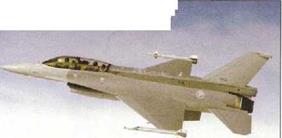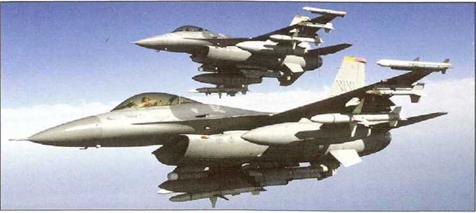Lockheed Martin F-16C/D
|
|
L |
ockheed Martin’s F-16C/D Fighting Falcon
(Lockheed acqu red General Dynamics in 1992 and became Lockheed Martin in 1995) is a development of the F-16A/B with structural, avionics and systems modifications. F-16C/Ds are distinguished oy an enlarged vertical fin base Cockpit changes irtc cde a wde-angle HUD_and an improved data display for HQTAS flying. The new APG-68 multimode radar brought increased range, sharper resolution and expanded operating modes, and a weapons interface for AGM-66D and AIM-120 AMRAAM missiles.
The first F-16C flew on 19 June 1984 and the initial production-standard F-16 Block 25 aircraft was acquired solely by the USAF. The Block 25 was first fitted with the Pratt & Whitney F100-PW-100 – later replaced by the more powerful -22Q/E engine.
The F-16C/D Block 30, which first flew in June 1986, introduced the General Electric F110-GE-100 engine as an alternative powerplant, and nearly all aircraft were fitted with the enlarged ‘oig mouth’ engine mlet. Weapons capability was expanded with the integration of the AGM-45 Shrike and AIM-120 AMRAAM, while new systems included the ALE-40 RWR and ALE-47 chaff/flare dispenser. Block 30 exports went to Greece, Israel and Turkey. The F-16C/D Block 32, also introduced in 1986, was powered by an uprated F100-PW-220 engine. The USAF’s Thunderbirds display team flies Block 32s and aircraft were delivered to Egypt, Korea.
The F-16C/D Block 40 Night Falcon mtmduced an all-weather precision attack capabi ity using the LANTIRN system. The Ft 10-GF-1 00-powered Block 40 has a w de-angle holographic HUD, improved APG-68(V) radar and avionics and GPS. The otherwise identical F-16C/D Block 42 s cowered by the F100-PW-220. The first USAF Block 40/42 aircraft were delivered in 1989. The Block 40 has been exported, to Bahrain, Egypt, Israel and Turkey.
The Block 50/52 F-16C/D incorporates all the improvements of the Block 40. more powerful engines, and integrates tne AGIvl-88 HARM missile and HARM Targeting System. Export customers include Korea, Singapore and Turkey.
Israel has developed a ‘big spine’ version of the Block 30/40 F-16D, which is believed to have a dedicated SEAD combat role. Similar aircraft have been delivered to Singapore. The designation F-16CG nas been applied to USAF Block 40/42 aircraft, and F-16CJ to Block 50/52s. The Block 60 is an enhanced systems next-generation F-16 variant now under development for the UAE.

 Specification: Lockheed Martin F-16C Block 52
Specification: Lockheed Martin F-16C Block 52
Powerplant: one 129.4-kN(29,1G0-lbl General ElECtric F110-GE-123 IPE afterburr ng turbofan Dimensions: wingspan, over aunchers 3.45 rn 131 ft): length 15.03 m (43 ft 4 ini; height 5.09 m (16 ft 8/ inj
Weights: empty 8581 kg (18,917 lb); maximum take-off 1229? kg (27.099 lb)
Performance: maximum level speed Ivlach 2 p. is: service ceiling 15240 m (50.030 ft); ferry range 4215 km (2,619 miles); combat radius 1485 km (923 miles!
Armament: one internal №61 Vulcan 20-nnm cannon with 511 rounds of ammunition; maximum ordnance 7072 kg (15,591 lb|

|
D |
esigned as an ‘Air Dominance Fighter’, The F-22 began from studies during the 1970s into low observable (LO} technologies, or ‘stealth’,and progressed to the ATF (Advanced Tactical Fighter)
programme launched by the USAF in April 1980. This was spurred by Soviet fighter developments that threatened to out-perform the F-15 Eagle and the outline requirement was for 750 new aircraft. After an evaluation of seven manufacturer’s proposals, Lockheed’s YF-22 and Northrop’s YF-23 designs were selected for competitive evaluation (demonstration/validation, or dem/val) in October 1986. Lockheed teamed with Boeing and General Dynamics to refine fin fact completely redesign) the aircraft and to share development cost and expertise. The revised YF-22 first flew on 29 September 1990. A second prototype aircraft flew on 30 October, but was damaged beyond repair after a flight control system failure in April 1992.
The Lockheed/Boeing team won the dem/val competition in April 1991. The F-22 team was awarded an engineering and manufacturing (EMD) contract to build nine pre-production aircraft. The first of These EMD F-22A Raptors (Raptor 4001) flew on 7 September 1997 and the second (Raptor 4002) followed on 26 June 1998.
Once it is fu/ly operational the F-22 will be the most capable combat aircraft in the world by far, but budget restrictions may hamper the programme.
One key element of the F-22’s ‘stealthy1 design is the need to carry all weapons internally to eliminate the huge effect they have on overall radar cross-section.
Many fundamental aspects of the F-22’s design, such as its same-plane wing and tailplane, and internal weapons bays are intended to minimise its radar cross-section, and make it ’stealthy’. Radar absorbent materials are used throughout. The lower weapons bay can carry up to six АІІУІ-120С AMRAAMs, with two AIM-9X Sidewinders in the side bay. A pair of GBU-32 JDAM bombs can be fitted in place of four of the AMRAAMs. A 20-mm Vulcan cannon fires from a ‘shoulder’ compartment on the right-hand upper fuselage. The F-22 is the first aircraft to be designed from the outset for vectored-thrusi control and for ‘supercruise’ (sustained supersonic flight without afterburner).
The APG-77 active array radar combines with sensors mounted around the airframe to create ‘sensor fusion’, presenting the pilot with an all- around ‘big picture’ of the air battle. A powerful datalink allows information to be passed between members of a flight and AWACS platforms.
Plans to acquire 648 F-22s have been cut back to 339. A lack of funds halted plans for a two-seat F-22B trainer in 1996. The F-22 is scheduled to enter service in 2005, but this date is sure to be delayed as ihe programme struggles with continuing funding cut-backs and technical hitches.

|
United States ‘Stealthy’ tactical bomber

|
W |
ith the lessons of the Vietnam and Yom Kippur Wars in mind, in 1974 the United States’ Defense Advanced Research Projects Agency (DARPA) began to look for ways to build a ‘stealthy’ aircraft. Using a mix of radar absorbent materials and a radar reflective internal/externa structure it was possible to dramatically decrease an aircraft’s radar cross-section (RCS). Lockheed demonstrated its expertise in this field (which began with the SR-71) when the ‘Skunk Works’ classified projects development centre built two sub-scale ‘Have Blue’ Technology demonstrators, which flew in 1977. They utilised a unique faceted structure to reduce RCS and, although both aircraft crashed during tests, the experience gained was sufficient to win Lockheed a contract to develop a full-scale operational tactical fighter. This was signed on 16 November 1978 and, under the ‘Senior Trend’ codename, Lockheed built five F-117 FSD prototypes, with a revised outboard-canted tail configuration. The first example flew on 18 June 1981 and the entire development programme and entry into service was conducted in total secrecy.
As production of 59 F-117As continued at a low rate, the USAF began establishing a base at Tonopah Test Range in Nevada. In October 1983, the first unit was declared operational, undertaking only night flights until November 1988, when the F-117 was publicly unveiled. The F-117 is commonly referred to as the ‘Stealth Fighter’, even though it
The F-117 is a key USAF asset, offering a combat- proven survivable precision-attack capability that is unique – apart from the B-2 Stealth Bomber.
is purely an attack aircraft. The official name Nighthawk has been adopted, but it is also wideiy referred to simply as The Black Jet’.
The F-117’s 1989 unspectacular combat debut in Operation Just Cause in Panama was overshadowed by its crucial contribution to Operation Desert Storm, when an eventual total of 42 aircraft flew from Saudi Arabia on nightly precision-attack missions destroying the most important targets Iraq and occupied Kuwait. The F-117 repeated this role during Operation Allied Force in 1999, when the F-117 suffered its only combat loss.
The F-117 is used for attacks against ’highly leveraged’ targets such as communications and command centres, air defence centres, bridges and airfields. It uses a system of two FLIR sensors to select Targets before dropping laser-guided bombs from its internal weapons bay. A post-Gulf War Offensive Capability Improvement Program (OCIP) has added two colour MFDs, a moving map display and auto-throttles. Further improvements will add a new IR acquisition and designation sensor.
From this angle it is easy to see why one of the less flattering nick-names that has been applied to the F-117 is the rcockroach
|













